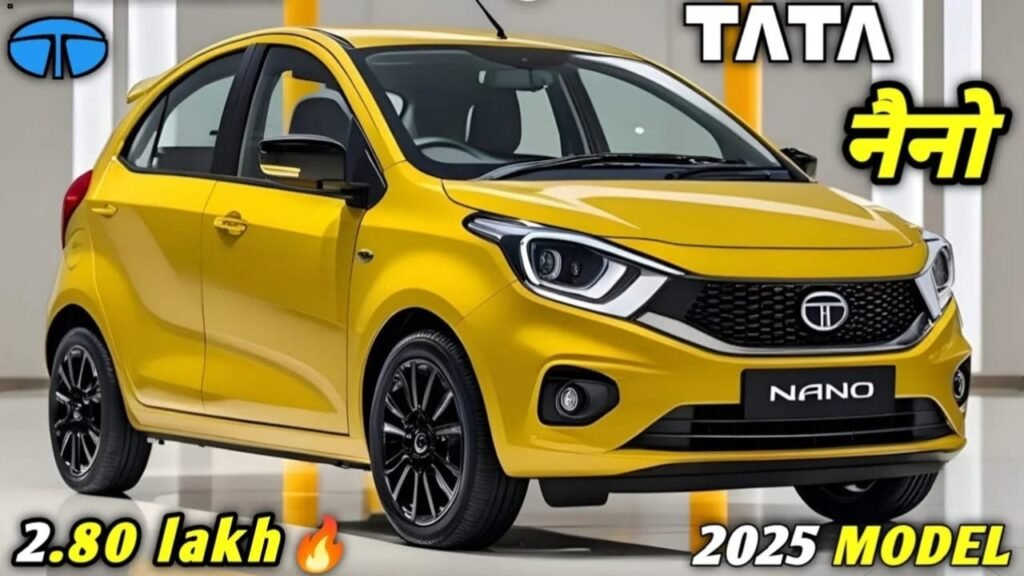Tata Nano Car Price :- The Tata Nano was launched in 2008 by Tata Motors with a groundbreaking vision — to provide an affordable and safe four-wheeler for every Indian family. Inspired by Ratan Tata’s mission to offer a car safer than two-wheelers for the masses, the Nano was priced at just ₹1 lakh (ex-showroom), making it the most budget-friendly car ever made.
Though sales did not meet initial expectations, the Nano became a symbol of Indian innovation. It made international headlines as the “cheapest car in the world” and stood as a bold attempt to redefine personal mobility for middle-class families.

Tata Nano Compact Design with Surprising Space
The Tata Nano’s design was both smart and practical. It had a tall-boy stance, short overhangs, and a cute, upright look, making it perfect for India’s crowded cities. Its small size (just over 3 meters in length) made it easy to park and maneuver, ideal for first-time drivers and urban users.
Despite being compact, the Nano’s interior surprised many. Thanks to its rear-engine layout, the cabin had generous legroom and headroom for four adults. The dashboard was simple and functional, and while the base model had minimal features, higher variants included AC, power steering, and a music system.
Tata Nano Small Engine, Big Efficiency
Powering the Nano was a 624cc two-cylinder petrol engine located at the rear of the vehicle — a rare layout in modern cars. It produced 37 bhp and 51 Nm torque, mated with a 4-speed manual transmission. While the power was modest, it was more than enough for city use.
One of the biggest strengths of the Nano was its excellent mileage. Delivering up to 23.9 km/l, it was among the most fuel-efficient petrol cars in India during its time. The car’s lightweight design also helped in achieving such high fuel economy, keeping running costs very low.
Tata Nano Simple Tech, Essential Features
In terms of technology, the Nano was basic by design, but got smarter over time. The original base variant was minimal, lacking power windows or central locking. However, later editions like the Nano Twist and GenX Nano introduced features such as power steering, Bluetooth music systems, remote locking, and even AMT (automatic transmission).
For city commuters, the GenX Nano AMT was a welcome update — offering clutchless driving at a low cost. It aimed to make the Nano appealing to urban youth and working professionals who wanted a compact automatic car on a budget.
Tata Nano Safety and Perception Challenges
Safety was one of the Nano’s weak areas. Early models did not include airbags or ABS, and a few incidents of engine fires affected public trust. Tata did make improvements in insulation and structural safety in later models, but by then, much of the market’s confidence was already lost.
Another issue was branding — promoting it as the “cheapest car” created a negative image. In India, many people associate vehicles with social status. As a result, some avoided Nano because they didn’t want to be seen driving a “cheap” car, even if it was practical and efficient.
Tata Nano Attempts to Revive & Market Upgrades
Tata Motors tried to revive interest through new variants and feature additions. The Nano Twist added power steering for easier handling, while the GenX Nano brought automatic transmission, improved design, better interiors, and color options. There were also special editions with sporty stickers, alloy wheels, and more youthful appeal. Tata Nano Car Price
Despite these efforts, competition from models like Maruti Alto and Renault Kwid made it tough for Nano to regain ground. Sales gradually declined, and in 2018, Tata officially ended Nano production, marking the close of a unique chapter in Indian automotive history.
Tata Nano Legacy of Innovation and Inspiration
Though it didn’t succeed commercially, the Tata Nano changed how the world viewed Indian engineering. It proved that frugal innovation was possible — a full-fledged car could be built affordably without compromising on basic safety or reliability. Nano became a case study in business schools globally.
Its legacy lives on in the hearts of Indian consumers who admired its purpose. For those who owned it, the Nano wasn’t just a car — it was a proud first step into four-wheel mobility. For the auto industry, it will always remain a milestone project in Indian manufacturing.
Final Thoughts :- The Tata Nano might not have conquered the sales charts, but it won something more valuable — respect for trying something no one had dared before. It democratized the idea of owning a car. Even years after its production ended, it’s remembered as a symbol of innovation, affordability, and hope for millions of Indians.
